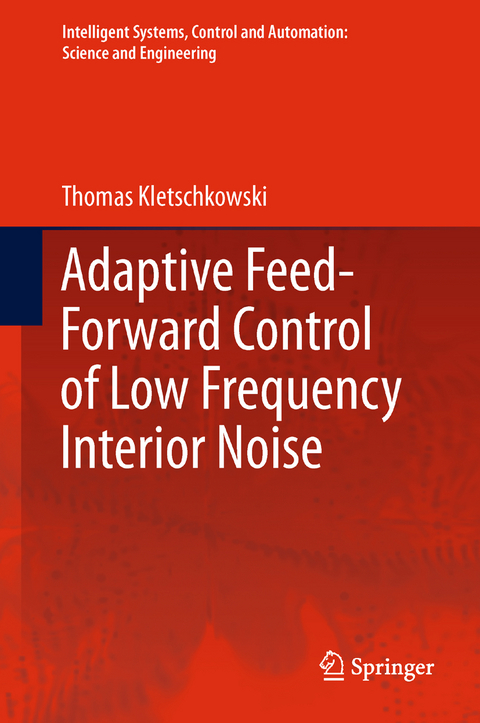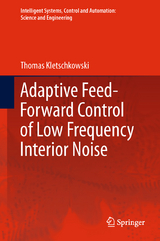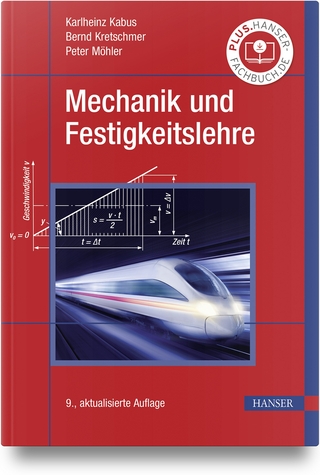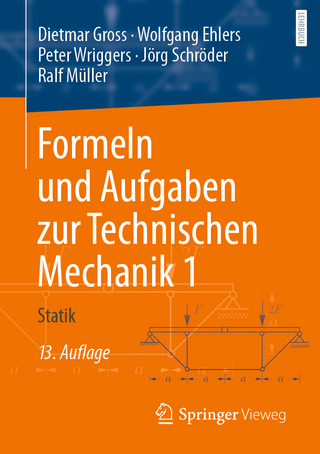Adaptive Feed-Forward Control of Low Frequency Interior Noise
This book presents a mechatronic approach to Active Noise Control (ANC). It describes the required elements of system theory, engineering acoustics, electroacoustics and adaptive signal processing in a comprehensive, consistent and systematic manner using a unified notation. Furthermore, it includes a design methodology for ANC-systems, explains its application and describes tools to be used for ANC-system design. From the research point of view, the book presents new approaches to sound source localization in weakly damped interiors. One is based on the inverse finite element method, the other is based on a sound intensity probe with an active free field. Furthermore, a prototype of an ANC-system able to reach the physical limits of local (feed-forward) ANC is described. This is one example for applied research in ANC-system design. Other examples are given for (i) local ANC in a semi-enclosed subspace of an aircraft cargo hold and (ii) for the combination of audio entertainment with ANC.
Thomas Kletschkowski is Privatdozent in the Department of Mechanical Enginieering of the Helmut-Schmidt-University/University of the Federal Armed Forces Hamburg.
Part I Introduction.- 1 Introduction to Interior Active Noise Control.- 1.1 Idea, Limit and Structure of Active Control Concepts.- 1.2 Remarks on Interior Noise and Active Control Approaches.- 1.2.1 Comments on the Interior Noise Problem.- 1.2.2 Comments on Active Control Approaches.- 1.2.3 A Qualitative Comparison of Active Control Approaches.- 1.3 Examples for Engineering Applications of Interior ANC.- 1.4 Objective of Book.- Part II The Mechatronic Background of Feed-Forward Active Noise Control.- 2 Comments on Signals and Systems.- 2.1 Comments on Signals.- 2.1.1 Classification.- 2.1.2 Characteristic Values and Functions.- 2.2 Comments on Systems.- 2.2.1 Definitions .- 2.2.2 Transfer Behaviour of LTI-Systems.- 3 Dynamics of Basic System.- 3.1 Basic Field Variables.- 3.2 Acoustic Field Equations.- 3.3 Energy Density and Sound Intensity.- 3.4 One-Dimensional Enclosed Sound Fields.- 3.4.1 Free Vibrations in One-Dimensional Sound Fields.- 3.4.2 Forced Vibrations in One-Dimensional Sound Fields.- 4 Sensors for Active Noise Control.- 4.1 Acoustical Sensing by Condenser Type Microphones.- 4.2 Sound Intensity Measurement.- 4.2.1 Functional Principle of Sound Intensity Probes.- 4.2.2 Errors in Sound Intensity Measurements.- 4.3 Structural Sensing by Accelerometers.- 5 Actuators for Active Noise Control.- 5.1 Electro-Dynamical Loudspeakers.- 5.2 Electro-Dynamical Panel Speakers.- 6 Active Control of Tonal and Broadband Noise.- 6.1 Mathematical Preparation.- 6.1.1 Hermitian Matrices.- 6.1.2 Quadratic Optimization.- 6.1.3 Steepest-Decent Algorithm.- 6.2 Terms and Structure of Feed-Forward Control Approaches.- 6.3 Review and Evaluation of Control Strategies.- 6.3.1 Description of Benchmark System and Close Form Solution.- 6.3.2 Analysis of Specific Control Strategies.- 6.3.3 Comparison of Control Strategies.- 6.4Multi-channel Control of Tonal Noise.- 6.4.1 Optimal Control of Tonal Noise.- 6.4.2 Adaptive Control of Tonal Noise.- 6.5 Active Control of Tonal Noise with Modified Cost Functions.- 6.5.1 Optimal Control Using a General Cost Function.- 6.5.2 Remote Sensor Control.- 6.5.3 Parametric Controller Design.- 6.6 Multi-channel Control of Stochastic Disturbances.- 6.6.1 Optimal Control of Stochastic Disturbances.- 6.6.2 Adaptive Control of Stochastic Disturbances.- 6.7 A Very Short Note on Adaptive Feedback Control.- Part III ANC-System Design: Theory.- 7 ANC-System Design Tools.- 7.1 Numerical Analysis of Sound Fields.- 7.1.1 A Short Overview on Numerical Methods.- 7.1.2 The Finite Element Method.- 7.2 Inverse Noise Source Identification.- 7.2.1 A Note on Source Identification Methods.- 7.2.2 The Inverse Finite Element Method.- 7.3 Initial Performance Estimation.- 7.3.1 Coherence Analysis.- 7.3.2 Transducer Placement Analysis.- 7.3.3 Correlation Analysis.- 7.3.4 Impulse Response Analysis.- 7.3.5 A Short Comparison of Initial Performance Estimators.- 7.4 Two Short Remarks on the Effect of Sampling Frequency.- 8 ANC-System Design Methodology.- 8.1 A Note on the Design Methodology for Mechatronic Systems.- 8.2 System Maturity Levels.- 8.3 A Design Methodology for ANC-Systems.- 8.3.1 ANC-System Design Tasks.- 8.3.2 ANC-System Design Steps.- 8.3.3 Matrix Model of the ANC-System Design Process.- Part IV ANC-System Design: Examples.- 9 Active Noise Control in a Semi-Closed Interior.- 9.1 Description of Problem and Requirements.- 9.2 Feasibility Study on ANC for the MA WA.- 9.2.1 Noise Field Analysis for the MA WA.- 9.2.2 Formulation of ANC-System Concept for the MA WA.- 9.2.3 Proof of MA WA ANC-System Concept.- 9.3 First Specification of Active Noise System.- 9.3.1 First Specification of Microphones.- 9.3.2 First Specification of Actuators.- 9.3.3 First Specification of Controller Software.- 9.3.4 Evaluation of First Specification.- 9.4 Weight, Cost and Efficiency Study.- 9.4.1 Actuator Design for ANC in the MA WA.- 9.4.2 Improvement of Adaptive Signal Processing.- 9.4.3 Optimization of Sensor and Actuator Locations.- 9.5 Sensitivity Study for ANC in MA WA.- 9.6 Robust Control of Sound in the MA WA.- 9.6.1 Design, Construction and Verification of Relevant Test Rig.- 9.6.2 Determination and Modelling of Uncertainties.- 9.6.3 Review of the MA WA Robust Control Approach.- 9.7 Design Process Summary.- 10 A Sound Intensity Probe with Active Free Field.- 10.1 Feasibility Study on an Active Intensity Probe.- 10.1.1 Analysis of the Controlled Sound Field.- 10.1.2 Formulation of SIAF-System Concept.- 10.1.3 Controller Design and Proof of SIAF-System Concept.- 10.2 First Specification of an Active Intensity Probe.- 10.2.1 First Specification of System Hardware.- 10.2.2 Test of First SIAF-Specification.- 10.3 Design Process Summary and Outlook.- 11 Active Noise Control Around Human Head.- 11.1 Feasibility Study on Local ANC in Bedrooms.- 11.1.1 Description of Bedroom Test Rig.- 11.1.2 Noise Field Analysis in the Transmission Test Rig.- 11.1.3 Anti-Noise Field Analysis in the Transmission Test Rig.- 11.1.4 Comments on Domain-Specific Design for Broadband ANC.- 11.1.5 System Integration and Functional Testing of Local ANC.- 11.1.6 Summary of Feasibility Study.- 11.2 Comments on the Application of Virtual Microphones.- 12 Active Noise Control and Audio Entertainment.- 12.1 Aircraft Interior Noise and ANC with Audio Entertainment.- 12.1.1 Comments on Aircraft Interior Noise.- 12.1.2 Comments on Hybrid ANC-Audio Systems.- 12.2 Feasibility Study on a Very Light Jet ANC-Audio System.- 12.2.1 In-Flight Measurements and Noise Field Analysis.- 12.2.2 Anti-Noise Field Analysis using a VLJ Mock-Up.- 12.2.3 Design of the ANC-Audio Controller.- 12.2.4 Integration and Test of the ANC-Audio Controller.- 12.2.5 ANC-Audio System Design Process Summary.- 13 Noise Source Localization in an Aircraft Cabin.- 13.1 Acoustic Ground Tests in an Aircraft Cross-Section.- 13.1.1 Description of the Aircraft Mock-Up.- 13.1.2 Description of Ground Test Experiments and Results.- 13.2 Inverse Calculation for an Aircraft Cross-Section.- 13.3 IFEM Application Summary.- Part V Summary.- References.- Index.
| Reihe/Serie | Intelligent Systems, Control and Automation: Science and Engineering ; 56 |
|---|---|
| Zusatzinfo | XXXVI, 330 p. |
| Verlagsort | Dordrecht |
| Sprache | englisch |
| Maße | 155 x 235 mm |
| Themenwelt | Naturwissenschaften ► Physik / Astronomie ► Mechanik |
| Technik ► Elektrotechnik / Energietechnik | |
| Technik ► Maschinenbau | |
| Schlagworte | Active control of sound • Adaptive signal processing • ANC-System Design Methodology • experimental noise field analysis • Mechatronics • numerical noise field analysis |
| ISBN-10 | 94-007-2536-1 / 9400725361 |
| ISBN-13 | 978-94-007-2536-2 / 9789400725362 |
| Zustand | Neuware |
| Haben Sie eine Frage zum Produkt? |
aus dem Bereich




